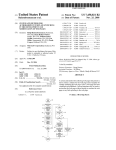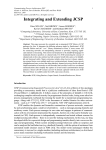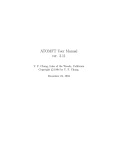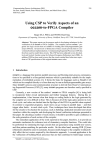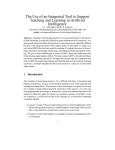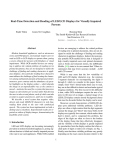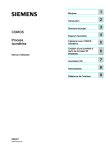Download Visual Environment for the Taylor integration in 3D Stereo
Transcript
Visual Environment for the Taylor integration in 3D Stereo Alexander Gofen The Smith-Kettlewell Eye Research Institute, 2318 Fillmore St., San Francisco, CA 94115, USA A cross-platform application called the Taylor Center implements advanced user interface and 2D or 3D stereo dynamic visualization of the solution. It integrates ODE's using the Modern Taylor method, having unlimited order of approximation, finite step, and high accuracy, allowing to explore or export the solution in different formats. Designed in Delphi-6, the package implements a powerful Graphical User Interface, and is portable to windowed versions of Linux too. Introduction What we expect from an application with advanced interactive visualization is: (a) User interface whose style, controls, and handlers fit best for the specific model and operational tasks; (b) Realistic visualization of the modeled process employing all appropriate faculties of the human perception, achievable with advanced hardware and multimedia. With that in mind we consider a general purpose program called the Taylor Center, which performs integration of initial value problems for systems of Ordinary Differential Equations (ODE's) [7,8]. Unlike earlier packages [1,2], this sophisticated Taylor Solver is designed for PCs as an interactive application with extensive Graphical User Interface. Moreover, it was developed in a programming environment which exemplified the Visual programming and made its good name: the Borland's Delphi (a dialect of Pascal having such advance features as dynamic arrays, objects, and sophisticated graphics). Actually the software may be considered as a cross platform Windows/Linux project because Borland offers also a Linux implementation of Delphi (called Kilex). Although not any mathematical object may be readily visualized, the solutions of ODE's are, as their geometrical interpretation is trajectories in Euclidian space En (planar curves for n=2). In a computerized world we can expect not just still images of trajectories, but also real time animation of the motion along them, and we can even expect visualization for n=3 too. This All-In-One application is called the Taylor Center (according to the metaphor of a "Music Center") because it offers an interactive environment, where researchers can input (import) ODE's in symbolic format, vary the parameters, explore the Taylor expansions and their convergence radius, integrate the equations with high accuracy (up to all available float point digits), store or export the results, graph the solutions and "play" them dynamically as bullet trajectories in real time animation. The feature making this application unique is that it can display non-planar 3D trajectories as anaglyphic stereo viewed through Red/Blue glasses [6,7]. In particular, it implements a 3D cursor (controlled by a conventional mouse). This cursor with "tactile" audio feedback allows users to "touch" points of non-planar curves hanging in thin air, while viewing the current 3D coordinates. Here the multimedia is employed in its full capacity (especially because of the stereo viewing – not yet ubiquitous in the computer world). Particularities of the 3D visualization The perspective drawing of 3D world (isometry) is known for a couple of centuries. Human imagination easily interprets perspectively correct planar images of common objects, especially those with strong perspective cues, but that is not always the case, and then human capability of stereo perception and tools for stereo vision come to play. Stereo vision is a powerful ability of our brain to recreate an image of 3D scene1 "fusing" the two planar images received by the eyes [3, 6]. Mental image of 3D space belongs completely to the realm of imaginary sensations, because there is no place in our body where any kind of 3D replica of reality is materialized. The only physical replica we do 1 Mathematically speaking, recreation of the 3D scene from a pair of 2D images is not a well defined problem, and it may have multiple solutions. have is the two planar images on the retina of our eyes. The real excitement of the 3D vision happens when we look at objects expected to be planar (a screen, a hologram), but the brain suddenly discovers a 3D scene in it, popping out from the planar surface or shifting back into the depth. This is the 3D Stereo Vision, or the real 3D – not to be confused with the misnomer "3D Graphics" used for video cards and video libraries. This misleading term emerged when the game and video technology switched from simplistic projections (known as front, side and top views in drawing) to a more advanced oblique projection of 3D scenes. Photos, isometric drawings, artistic paintings (if their perspective is correct) all are examples of such projection. When we look at them, we perceive them exactly as planar 2D projections of 3D reality2. We have all become good at "reading" these projections and understanding the 3D reality they represent. Such projections were the closest we could come to 3D imagery until invention of the stereoscope in 19th century in Great Britain. The two eyepieces of a stereoscope deliver the two planar images of a stereo pair directly to the respective eyes. Then a miracle occurs: viewers perceive the 3-dimesionality of the scene as real – so real that they wish to touch the objects hanging in air. This never happens when we look at 2D projection of the 3D world. After the stereoscope, many other techniques were developed for displaying 3D stereo images [4]. Except for the holograph, they all use the same basic principle as the stereoscope: to deliver each of the two images of a stereo-pair to the proper (and only to the proper) eye. On the contrary, the holographic equipment completely reproduces the 3D light front, i.e. the 3D vector field of the same electromagnetic waves that would be reflected by the 3D scene if it were really there. Thus a hologram creates a sculptural "ghost" in the real world as a physical phenomenon – a 3D scene we view by a pair of eyes, while a stereo pair creates this scene in our mind – an ultimate addressee anyway. Another fundamental difference is in the 2 Binocular viewing of a perspectively correct planar image creates perception of a planar drawing only: isometric or not, yet in a plane. That is because this plane is the solution corresponding to the 3D reality encoded in this stereo pair. Surprisingly enough, if the same isometry is viewed by one eye at the perspectively correct distance, with a little effort the brain does generate the stereo perceptions of this very scene reconstructing it out of the perspective cues – a phenomenon called monocular stereopsis. quantity of information: a stereo pair is just two planar images, while a hologram encodes (almost) infinity of them. Does the stereo vision give some advantages vs. a planar perspective projection of a 3D scene? The isometrics (or photo-imaging) suffice in many, but not in all situations. In displaying such objects as scenes with rectangular shapes, bodies with edges, skeletal structures, scenes with good perspective cues or with reflection hints, isometry is good enough. For them, the stereo viewing only adds certain excitement in perception. Yet the isometrics works poorly for smooth surfaces without edges (smooth 2D manifolds). For example, to perceive a picture of a sphere or a torus, we additionally draw grids on their surfaces, or special shadows and reflections. The 2D projections become especially inefficient while visualizing non-planar curves (1D manifolds) – and that is what solutions of ODEs are. For example, trajectories of space probes launched to planets of Solar system are usually non-planar. To draw them in conventional isometry we need to add several auxiliary planes and referencing coordinate lines. The real stereo viewing eliminates necessity in all auxiliary hints (see the 3D demo samples). Thus, displaying non-planar solutions of ODEs in 3D stereo dramatically improves the perception3. This particular software employs the cheapest technical realization of stereo vision, known as anaglyph stereo, which requires nothing more than a conventional PC monitor plus cardboard glasses – the cheapest gear possible [6]. The two images of an anaglyphic stereo pair must be monochromatic – each in a different color (one of the basic Red/Green/Blue set). The Red/Blue pair is better because their spectrums are farther away from each other and better separable. When you look through the Red/Blue glasses at the Red/Blue images of a stereo pair that overlap on a screen, each eye receives only the proper image of the stereo pair. How does the brain fuse stereo pairs presented in different colors? After all it evolved and is trained to match corresponding elements of stereo pairs, and the corresponding elements must be of the same color indeed. Fortunately, the brain follows not a "rigid", but rather a "flexible" algorithm. Certain neurons fire if they find out recognizable elements in the image disregarding their colors, while the others There are many other cases when stereo viewing becomes essential, being implemented in various equipment from micro- to telescopes [4]. For example it is used to visually detect counterfeit bills, or changes in aerial photos of landscapes. 3 fire if these elements happen to comprise a "meaningful" stereo pair. The signals of those "stereo-specialized" neurons dominate. As a result we easily fuse the 3D scene in spite of the fact, that each eye sees it in a different color. This works well both on a PC monitor for a single viewer, and with a screen projector for a large audience. The modern technology nowadays offers a variety of other technical solutions with completely uncompromised stereo viewing. Particularities of the integration method: more than tabulated functions The method of integration implemented in this software is the modern Taylor method – to be distinguished from its classical counterpart in that the process of n-order differentiation was optimized and made feasible due to the concepts of Automatic Differentiation (AD) and (generalized) elementary functions [5]. Among other methods of integration, the Taylor method is situated somewhere between purely numerical methods and symbolic integration. However, unlike purely numeric methods, it delivers not only tabulated values of unknown functions in point of interests, but also their derivatives up to any specified order (default 30) and convergence radius at every point. And unlike symbolic integration, the Taylor method applies not only to very limited list of ODEs solvable in quadratures, but to any ODEs in regular points of the phase space. From the programmatic point of view, any Taylor solver differs from conventional integrators in that the input – an Initial Value Problem for ODEs – should be provided not simply as a subroutine computing the right hand parts, but rather as arithmetic expressions themselves of those right hand parts in order to enable automatic differentiation (understood as optimized classical formulas for n-th order derivatives applied to sequences of basic expressions). Correspondingly, the output and interaction of a Taylor solver with other applications has its specifics too. The result is not just tabulated values of the solution, but rather its expansion into the Taylor series (analytical elements), or a sequence of such elements (although the tabulated solution may be exported also). The tasks and environment at a glance This section walks you through the basic features of the Taylor Center, pre-loaded with fascinating classical problems. You will be able to "play" them in real time animation, to experiment with a 3D cursor, and to study effects of specific parameters. To install the program [8], unzip it into an empty folder of your choice and run TCenter.exe. To try first what makes this program unique, begin with the 3D stereo and have Red/Blue glasses ready. Go to Demo/Three Bodies/Disturbed/3D in the menu. The compilation script runs and ends with a message "Compilation successful", displaying a knotty Red and Blue curves. Now put on your anaglyphic glasses (over those you usually use, if any) and maximize the Graph window. What you hopefully perceive looks like a "fishing line" hanging in thin air between the monitor and your face. These are trajectories of three bodies moving under gravitational pull. More specifically, this is the so called disturbed Lagrange case. (See Lagrange case proper under Three Bodies/Symmetrical). This "fishing line" is a result of small disturbances applied perpendicularly to the initial plane (the plane of your screen). However the program is capable of producing something more than "still life". Click the Play button, initiating real time 3D stereo motion of the bullets representing the three bodies, and watch how they accelerate, decelerate, and couple. When they come to rest, you may try exploring the elements of the trajectories with a "tactile" 3D cursor. Move it into the scene, where it will transform into a small cross. The mouse always moves the stereo cursor in a plane parallel to the screen. To control its depth, use the mouse wheel. (If the mouse wheel is not available, move the mouse keeping depressed either Ctrl key to bring the cursor closer to your eyes, or Shift key – to move it away from you). Current 3D coordinates of the cursor always appear at the top window panel. Now, controlling the 3D cursor, try to touch one of the trajectories in space with it. Switch the speakers On, and you will hear a clicking sound when the touch occurs: this is the so called "tactile" audio feedback, helping to explore points of interest in the curves. You can rotate the curves in the space with the Turn controls. Given specific sizes of the parallelepiped, you may notice that the front side (controlled by MaxZ value) keeps the curves inside the parallelepiped "flattening" them. (Therefore increase MaxZ). Already familiarized with the 3D stereo features of the package, you may try several other problems. Click Main Panel in the menu to revisualize the main form, and go to Demo/Four Bodies. The two pairs of bodies with equal masses are all initially placed in a horizontal plane, parallel to your desk (perpendicular to the screen). The horizontal components of the velocities provide near circular motion for each coupled pair, while the small vertical components push the two pairs into a large circular motion around the center of the masses (see the initial values in the Main window). At the beginning the trajectories spin into a braid looking as though they outline a torus (like the tiny braided rings of Saturn discovered by the Voyager probe). However this braid actually does not outline a torus: you can notice that both coupled pairs preserve their initially horizontal plane. Another fascinating example of 3D motion is under Demo/Möbius. You can watch 4 bullets lined up in a straight line whose motion outlines a Möbius surface winded 1.5. To get the simplest one (winded 0.5), change value of n=0.5 (in Constants), Compile, click button Previous (in Graph setting page), click Clear in Graph window, and finally click the More button. You can explore several more 3D stereo examples opening their scripts. Click the Main Panel and go to File/Open script menu item. Here are files producing 3D stereo images: PendulumApple.scr, PendulumFlower.scr (spherical pendulum); KnotChain3D.scr, TrefoilKnot3D.scr; MobiusLarge.scr; Beside 3D stereo samples, there are also instructive examples in 2D, such as the recently discovered eight-shaped solution of the three body problem called "Choreography" (in Three Bodies/Choreography). Under File/Open script there are also two more classical examples in celestial mechanics: the Euler case with the bodies of equal masses (3EqBodEuler.scr) and the case when one mass is near zero (3NonEqBodEuler.scr). There are also scripts for single and double pendulums, and the Four body Lagrange case (4BodiesPlane.scr). Conclusions Summarizing all the features, with the current version of the Taylor Center users can: • Specify and study the Initial Value Problems for virtually any system of ODE's in the standard format of explicit 1st order ODE's with numeric and symbolic constants and parameters; • Perform numerical integration of Initial Value Problems with the high accuracy (up to all digits of 64-bit mantissa), while the step of integration remains finite and does not approach zero (because the order of approximation is high: by default 30, or higher). • Obtain the solution as a set of analytical elements – Taylor expansions covering the required domain, exportable to other systems either as is, or in tabular format; • Study Taylor expansions and the (heuristic) radius of convergence for the solution at all points of interest (with the only limitation that the terms in the series do not exceed the maximum value of about 104932 implied by the 10-byte implementation of the real type extended); • Perform integration either "blindly", or graphically visualized; either a given number of steps, or until an independent variable reaches a terminal value, or until a dependent variable reaches a terminal value; • Switch integration between several versions of ODE's defining the same trajectory with respect to different independent variables. For example, it is possible to switch the integration by t to that by x or y in order to reach the terminal value (or zeros) of the dependent variable; • Integrate piecewise-analytical ODE's; • Specify different methods of controlling the accuracy and the step size; • Specify accuracy for individual components either as an absolute or relative error tolerance, or both; • Graph color curves (trajectories) for any pair of variables of the solution up to 7 on one screen, either as plane projections, or as 3D stereo images to be viewed through anaglyphic (Red/Blue) glasses. The 3D cursor with audio feedback (controlled by a conventional mouse) enables "tactile" exploration of the curves literally "hanging in thin air"; • "Play" dynamically the near-real time motion of bullets along the computed trajectories either as 2D or 3D stereo animation; • Graph a field of directions with a grid of short lines or curves of variable length; • Explore several meaningful examples supplied with the package such as the problem of Three or Four Bodies, "Choreography". Symbolic constants and expressions parameterize the equations and initial values making it possible to try different initial configurations of special interest. The current kernel version may be further developed in different directions (Fig 1): - To implement other types of arithmetic (complex numbers, intervals); - To generate compileble code in Assembler or in a high level language; - To simultaneously integrate an array of Initial Value Problems; - To compute derivatives by parameters. - To implement special loops and array variables (to automate expressions of high complexity in the right hand sides such as sums of many terms). References [1] Chang, Y. F. ATOMFT User Manual. 1986. Claremont McKenna College, Claremont, CA, 91711 [2] Chang Y. F., Corliss G.: ATOMFT: Solving ODEs and DAE Using Taylor Series. Computers Math. Applic. Vol. 28, No. 10-12, 1994. pp. 209233. [3] Howard, I.P., Rogers B.J. Seeing in Depth, Vol. 2, Depth perception. Published by I. Porteous, Toronto, University of Toronto Press, 2002, 626 p. [4] Ibid. Chapter 30, Stereoscopic Techniques and Applications, pp. 541-564 [5] Gofen, A. M.: ODEs and Redefining the Concept of Elementary Functions. In: P.M.A. Sloot et al. ICCS 2002, LNCS 2329. SpringerVerlag, Berlin 2002. [6] Gofen, A. Stereo Vision on Your Home PC. Delphi Informant, Vol. 10, No. 1, 2004, pp. 815. [7] Gofen, A. Interactive Environment for the Taylor integration (in 3D Stereo), in: "Proceedings of the 2005 International Conference on Scientific Computing" (CSC'05, June 2005, USA); Editors: H. R. Arabnia and G. A. Gravvanis, pp. 67-73. [8] Gofen, A. M.: The Taylor Center Demo for PCs and the User Manual. www.ski.org/gofen/TaylorMethod.htm The Taylor Center: Structure and Data Flow Portable to windowed Linux (not yet implemented) Source data Graphics and animation Interactive environment to input ODEs, to control the integration and output. Parsing and compiling into… Instructions for the AD-processor Real type extended Emulator of abstract ADProcessor(1) External systems: Other value types Instructions in Assembler or high level languages – to be compiled and run in other systems to achieve the ultimate speed(2) Emulator of AD-Processor for: complex numbers, real numbers of any length, intervals(2) The solution as analytical elements The tabulated solution (1) (2) Native Intel 10 byte float point numbers (64 bit mantissa) Not yet implemented Fig 1. The outline of the Taylor center kernel. The source ODE's, symbolic constants and initial values are entered in editor boxes or from a file. The interactive environment controls how to integrate, what to graph, and what to export. The dotted boxes represent features possible in future developments.





